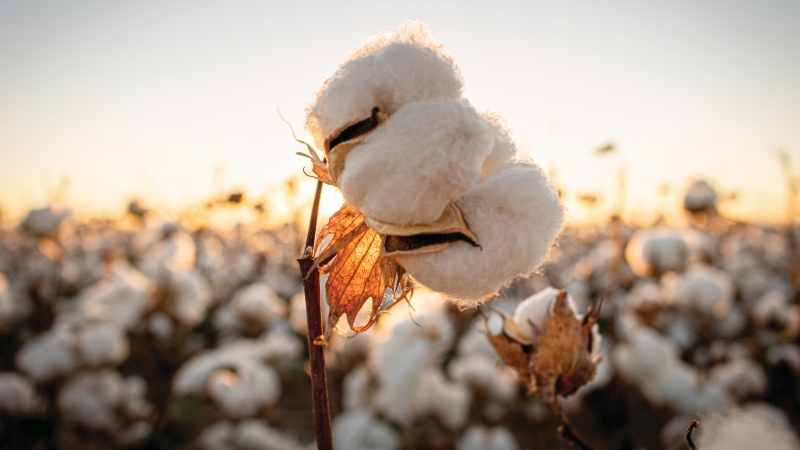A FIRST FOR THE COTTON INDUSTRY
AxantTM Flex herbicide trait technology, a quadruple stack herbicide-resistant trait package, will offer growers more options and improved flexibility to manage weeds

Kenny Melton, Ph.D
BASF’s Kenny Melton calls it a dramatic new innovation for the cotton industry. Melton, Ph.D., the Western Region Agronomic Manager for BASF Agricultural Solutions, is talking about BASF’s new industry-first Axant Flex technology – a quadruple stack herbicide-resistant trait package for cotton growers to battle difficult-to-control weeds like Palmer amaranth. BASF plans to bring the
Axant Flex technology to market in select Stoneville® and FiberMax® cotton varieties in the near future pending regulatory approvals.
Axant Flex technology provides tolerance to AliteTM 27 herbicide (isoxaflutole), BASF’s newest herbicide for cotton, which is awaiting regulatory approval. The technology also provides resistance management to the BASF herbicides Liberty® (glufosinate-ammonium) and Engenia® (dicamba) as well as glyphosate. “To introduce a completely new mode of action for cotton herbicide is really going to be great for weed management and resistance management as well,” Melton said.
| “THAT EXTENDED CONTROL GIVES GROWERS A LOT MORE ABILITY TO BE ABLE AND GET IN THERE WITH THEIR POSTEMERGENCE APPLICATIONS ONCE THE PRE EMERGENCE APPLICATIONS BEGIN BREAKING DOWN.” – KENNY MELTON |
The Axant Flex technology offers cotton growers more options and improved flexibility to manage weeds, Melton stressed. Alite 27 herbicide will play a major role in this. When it’s approved for use on cotton containing the Axant Flex herbicide tolerance trait, Alite 27 herbicide will provide more flexibility for many growers earlier in the season. It can be applied pre-emergence or early post-emergence and can also be tank mixed with other approved residual and knockdown herbicides.
After pre-emergence herbicides are applied and their impact wears off, growers must be “Johnny on the spot” with their next residual application and/or postemergence application, Melton said, noting it’s better to spray weeds when they’re young with glyphosate, glufosinate-ammonium, or dicamba. “With the ability to add in this pre-emergence application of Alite 27 herbicide along with another approved pre-emerge herbicide, what that’s going do is extend the length of pre-emergence control,” Melton explained, noting that trials of Alite 27 herbicide show that it’s generally adding 14 days of extra control.

“That extended control gives growers a lot more ability to be able to get in there with their post-emergence applications once the pre-emergence applications begin breaking down.” In other words, growers don’t have to be as “Johnny on the spot” with their next applications. “Growers will have a wider window,” Melton said. “They don’t have to get out there quite as quickly.” While the active ingredient of Alite 27 herbicide has been used on corn, its eventual approval for herbicide-tolerant cotton will open a new door for growers, Melton said.
“We’ve already been putting a lot of pressure on the weed populations with glyphosate for many years, and we’re seeing a few issues with some resistance and reduced control with glufosinate and dicamba in some areas,” he added. “To be able to have an entirely new mode of action for cotton with Alite 27 herbicide will help growers by giving them another way to control weeds without putting so much pressure on any one type of control.” When the Axant Flex technology is launched, BASF will have its own proprietary germplasm within its Stoneville and FiberMax brands, Melton said. “Growers will have more to choose from in terms of the germplasm,” he added.
In addition to the germplasm, Melton said BASF has been working on incorporating more native traits into Stoneville and FiberMax varieties. “We’re going to have more offerings in terms of rootknot nematode tolerance, and it won’t be long before we’ll have offerings with reniform nematode tolerance,” he added. “And we’ll soon have more offerings that are resistant to bacterial blight and verticillium wilt. We’re working hard on the native traits because we know those are important as well.”
Alite 27 herbicide and Engenia herbicide are U.S. EPA Restricted Use Pesticides. Every application of Engenia herbicide requires the use of a pH buffering adjuvant such as AEOGOS Buffering Technology. Alite 27 herbicide is pending regulatory approval for use in cotton. Axant is a trademark of BASF for the HPPD-tolerant trait and is pending regulatory approval for commercialization in cotton. Always read and follow label directions. e3, Engenia, FiberMax, Liberty, LibertyLink, Stoneville and the Stoneville design are registered trademarks of BASF. © 2022 BASF Corporation. All rights reserved.




